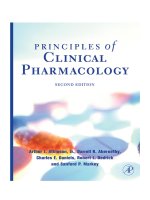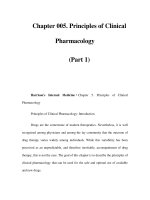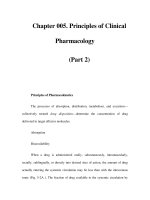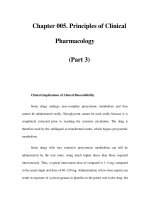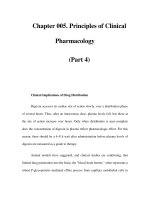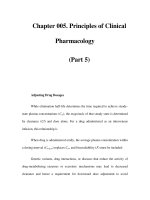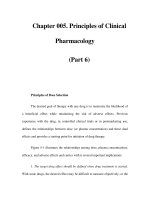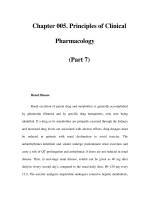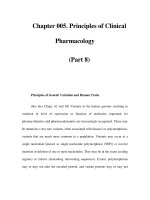Chapter 005. Principles of Clinical Pharmacology (Part 8) pot
Bạn đang xem bản rút gọn của tài liệu. Xem và tải ngay bản đầy đủ của tài liệu tại đây (16.71 KB, 6 trang )
Chapter 005. Principles of Clinical
Pharmacology
(Part 8)
Principles of Genetic Variation and Human Traits
(See also Chaps. 62 and 64) Variants in the human genome resulting in
variation in level of expression or function of molecules important for
pharmacokinetics and pharmacodynamics are increasingly recognized. These may
be mutations (very rare variants, often associated with disease) or polymorphisms,
variants that are much more common in a population. Variants may occur at a
single nucleotide [known as single nucleotide polymorphism (SNP)] or involve
insertion or deletion of one or more nucleotides. They may be in the exons (coding
regions) or introns (noncoding intervening sequences). Exonic polymorphisms
may or may not alter the encoded protein, and variant proteins may or may not
display altered function. Similarly, polymorphisms in intronic regions may or may
not alter gene expression and protein level.
As variation in the human genome is increasingly well documented,
associations are being described between polymorphisms and various traits
(including response to drug therapy). Some of these rely on well-developed chains
of evidence, including in vitro studies demonstrating variant protein function,
familial aggregation of the variant allele with the trait, and association studies in
large populations. In other cases, the associations are less compelling. Identifying
"real" associations is one challenge that must be overcome before the concept of
genotyping to identify optimal drugs (or dosages) in individual patients prior to
prescribing can be considered for widespread clinical practice. Nevertheless, the
appeal of using genomic information to guide therapy is considerable.
Rates of drug efficacy and adverse effects often vary among ethnic groups.
Many explanations for such differences are plausible; genomic approaches have
now established that functionally important variants determining differences in
drug response often display differing distributions among ethnic groups. This
finding may have importance for drug use among ethnic groups, as well as in drug
development.
Genetically Determined Drug Disposition and Variable Effects
The concept that genetically determined variations in drug metabolism
might be associated with variable drug levels, and hence effect, was advanced at
the end of the nineteenth century, and the first examples of familial clustering of
unusual drug responses due to this mechanism were noted in the mid-twentieth
century. Clinically important genetic variants have been described in multiple
molecular pathways of drug disposition (Table 5-1). A distinct multimodal
distribution of drug disposition (as shown in Fig. 5-6) argues for a predominant
effect of variants in a single gene in the metabolism of that substrate. Individuals
with two alleles (variants) encoding for nonfunctional protein make up one group,
often termed poor metabolizers (PM phenotype); many variants can produce such
a loss of function, complicating the use of genotyping in clinical practice.
Individuals with one functional allele make up a second (intermediate
metabolizers) and may or may not be distinguishable from those with two
functional alleles (extensive metabolizers, EMs). Ultra-rapid metabolizers with
especially high enzymatic activity (occasionally due to gene duplication; Fig. 5-6)
have also been described for some traits. Many drugs in widespread use can inhibit
specific drug disposition pathways (Table 5-1), and so EM individuals receiving
such agents can respond like PM patients (phenocopying). Polymorphisms in
genes encoding drug uptake or drug efflux transporters may be another contributor
to variability in drug delivery to target sites and, hence, drug effects. However,
loss-of-function alleles in these genes have not yet been described.
CYP Variants
CYP3A4 is the most abundant hepatic and intestinal CYP and is also the
enzyme responsible for metabolism of the greatest number of drugs in therapeutic
use. CYP3A4 activity is highly variable (up to an order of magnitude) among
individuals, but the underlying mechanisms are not yet well understood. A closely
related gene, encoding CYP3A5 (which shares substrates with CYP3A4), does
display loss-of-function variants, especially in African-derived populations.
CYP3A refers to both enzymes.
CYP2D6 is second to CYP3A4 in the number of commonly used drugs that
it metabolizes. CYP2D6 is polymorphically distributed, with about 7% of
European- and African-derived populations (but very few Asians) displaying the
PM phenotype (Fig. 5-6). Dozens of loss-of-function variants in the CYP2D6 gene
have been described; the PM phenotype arises in individuals with two such alleles.
In addition, ultrarapid metabolizers with multiple functional copies of the
CYP2D6 gene have been identified, particularly among northern Africans.
CYP2D6 represents the main metabolic pathway for a number of drugs
(Table 5-1). Codeine is biotransformed by CYP2D6 to the potent active metabolite
morphine, so its effects are blunted in PMs and exaggerated in ultrarapid
metabolizers. In the case of drugs with beta-blocking properties metabolized by
CYP2D6, including ophthalmic timolol and the sodium channel–blocking
antiarrhythmic propafenone, PM subjects display greater signs of beta blockade
(including bradycardia and bronchospasm) than EMs. Further, in EM subjects,
propafenone elimination becomes zero-order at higher doses; so, for example, a
tripling of the dose may lead to a tenfold increase in drug concentration. The oral
hypoglycemic agent phenformin was withdrawn because it occasionally caused
profound lactic acidosis; this likely arose as a result of high concentrations in
CYP2D6 PMs. Ultrarapid metabolizers may require very high dosages of tricyclic
antidepressants to achieve a therapeutic effect and, with codeine, may display
transient euphoria and nausea due to very rapid generation of morphine.
Tamoxifen undergoes CYP2D6-mediated biotransformation to an active
metabolite, so its efficacy may be in part related to this polymorphism. In addition,
the widespread use of selective serotonin reuptake inhibitors (SSRIs) to treat
tamoxifen-related hot flashes may also alter the drug's effects since many SSRIs
(fluoxetine, paroxetine) are also CYP2D6 inhibitors.
The PM phenotype for CYP2C19 is common (20%) among Asians and
rarer (3–5%) in European-derived populations. The impact of polymorphic
CYP2C19-mediated metabolism has been demonstrated with the proton pump
inhibitor omeprazole, where ulcer cure rates with "standard" dosages were
markedly lower in EM patients (29%) than in PMs (100%). Thus, understanding
the importance of this polymorphism would have been important in developing the
drug, and knowing a patient's CYP2C19 genotype should improve therapy.
There are common allelic variants of CYP2C9 that encode proteins with
loss of catalytic function. These variant alleles are associated increased rates of
neurologic complications with phenytoin and of hypoglycemia with glipizide. The
angiotensin-receptor blocker losartan is a prodrug that is bioactivated by CYP2C9;
as a result, PMs and those receiving inhibitor drugs may display little response to
therapy.
